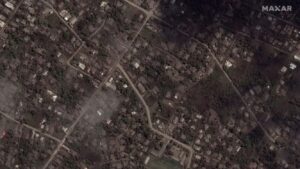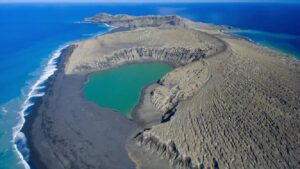Tonga Volcano Eruption Triggered Megasunami
An analysis of the megatsunami triggered by the Tonga volcano eruption has revealed waves as high as 40 meters. It was a record-breaking eruption – the most powerful since Krakatoa in 1883. Mathilde Fontez, editor in chief of Epsiloon magazine, discusses the devastating Tonga volcano eruption that shook the Tonga Islands on January 15, 2022, and the megatsunami it created.
Scientists have analyzed the tsunami that this massive eruption caused over a year ago?
Mathilde Fontez: Yes, just over a year ago, a submarine volcano erupted suddenly in the Tonga Islands in the Pacific Ocean. It was a record-breaking eruption – the most powerful since Krakatoa in 1883. It was heard as far away as Alaska, more than 8,000 km from the volcano. It caused an earthquake measuring 5.8 on the Richter scale. Its plume rose to 58 km above sea level – beyond the stratosphere – and the shock wave circled the earth multiple times.
 Maxar satellite image from January 18, 2022, three days after the major eruption of the Hunga Tonga-Hunga Ha’apai volcano in the Tonga archipelago in the Pacific, showing the city of Tongatapu covered in ash. (MAXAR/DIGITAL GLOBE/GETTY IMAGES)
Maxar satellite image from January 18, 2022, three days after the major eruption of the Hunga Tonga-Hunga Ha’apai volcano in the Tonga archipelago in the Pacific, showing the city of Tongatapu covered in ash. (MAXAR/DIGITAL GLOBE/GETTY IMAGES)
Geophysics experts immediately began studying this extraordinary event. Now, a team at the University of Miami has produced an analysis of the tsunami associated with the eruption.
Was there a global tsunami?
Yes, and researchers measured it immediately. There was first a wave 1.2 meters high that hit the capital of Tonga 20 minutes after the explosion. Then, a wave of a few tens of centimeters crossed the Pacific Ocean at the speed of sound and was detected as far away as the Mediterranean.
But what was missing was the analysis of the local tsunami in the lagoon of the Tonga archipelago. This is what these researchers have done: they have collected all the satellite data taken before and after the eruption, drone images, photos, and field observations, and they have studied 118 sites on 10 Tonga islands. They have been able to simulate the tsunami.
What they see is that on the north side of Hunga Tonga, the waves reached 85 meters high, a minute after the explosion. On the south side, they were 65 meters high. Twenty minutes after the explosion, they recorded waves 45 meters high along the entire coast of Tofua Island, 90 kilometers to the north. In short, the data places the phenomenon in the category of megatsunamis. Once again, the Tonga eruption is proving to be totally unprecedented.
 Aerial view of the Hunga Tonga volcano on August 20, 2018. (YVES GLADU/GAMMA-RAPHO VIA GETTY IMAGES)
Aerial view of the Hunga Tonga volcano on August 20, 2018. (YVES GLADU/GAMMA-RAPHO VIA GETTY IMAGES)




























































